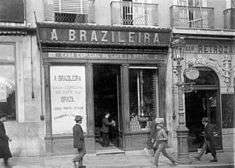Bica (coffee)
Bica is the term commonly used in certain areas of Portugal for a "café" (coffee in Portuguese) that is similar to espresso,[1] but extracted to a greater volume than its Italian counterpart (akin to a lungo in Italy) and a little bit smoother in taste, due to the Portuguese roasting process being slightly lighter than the Italian one.
 A Bica coffee by Delta Cafés | |
| Type | Beverage |
|---|---|
| Place of origin | Portugal |
| Main ingredients | Light roast coffee beans, water |
In almost all regions in Portugal, it is simply called 'um café' (a coffee in Portuguese) and always served in a Demitasse cup.
The name bica originates from the way the coffee flows, falling from the espresso machine to the cup on the tray,[2] an analogy with a water spring or fountain, both can also be called bica in Portuguese.
History

The A Brasileira coffeehouse was opened by Adriano Telles on 19 November 1905 at No.122 (an old shirt shop), to sell "genuine Brazilian coffee" from the Brazilian state of Minas Gerais, a product generally unappreciated in homes of Lisboetas of that period. In order to promote his product, Telles offered each shopper who bought a kilogram of ground coffee (for 720 réis) a free cup of coffee. It was the first shop to sell the "bica", a small cup of strong coffee, similar to espresso, with fresh goat milk from nearby farms.[3]
There's a belief among many (Lisbon) locals that states "Bica" as an acronym for "Beba isso com açúcar", which literally means "Drink this with sugar".
Outside Portugal
Following mass immigration post-World War II, Bica coffee is now served in Montreal and other centers of Portuguese migration abroad, namely Fall River, New Bedford, Toronto, and East Providence, RI.[4]
See also
- Galão
- Cimbalino
References
- http://www.infopedia.pt/dicionarios/lingua-portuguesa/bica
- Neves, Orlando (2001). Dicionário da origem das palavras. Lisbon: Lisboa Editorial Notícias. ISBN 9724611876.
- "Portugal's Coffee: A Sumptuous and Delectible Treat". Retrieved 31 December 2011.
- "Cafe Bica". Retrieved 11 February 2015.
